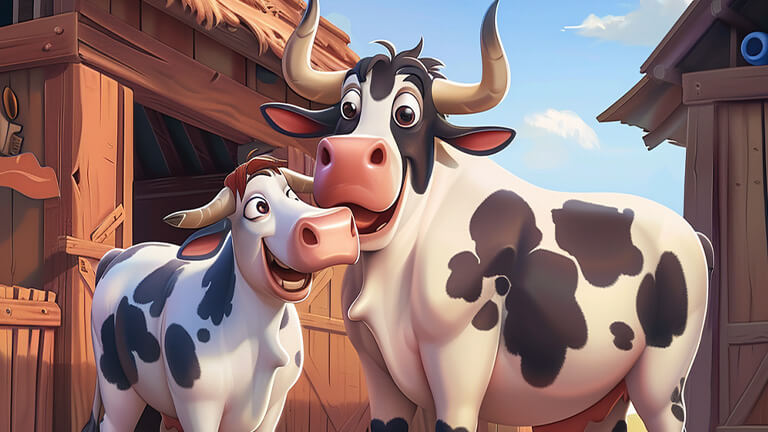Reproduction #

Sooner or later, every livestock breeder faces the question of expanding the number of his livestock. The more cows, bulls and calves you have, the greater the volume of products produced in the form of meat, milk, leather and other resources.
There are two main ways to increase the number of cattle:
- purchasing new animals at the fair or state farm nursery, if available. This is a fairly simple and quick way to replenish your herd, but it requires significant financial investments;
- breeding and raising your own young animals by mating existing cows and bulls. This method is more interesting and potentially more profitable, since it allows you to get new calves without additional costs for purchasing livestock.
Next, we will look in detail at the entire process of preparing cows and bulls for mating, the mating itself using both our own and rented producers, the birth and rearing of young animals
Preconditions for mating #
In order to mate cattle and produce offspring, it is necessary to prepare a suitable pair of animals - a cow and a bull, ready for reproduction. You can use your own cow and bull, or rent a bull at the fair if you only have only a ready-to-mate cow.
Both the cow and the bull must meet certain requirements. Each animal must be between 61 and 420 days old inclusive. Weight not less than 320 kg. A prerequisite is complete readiness for mating, which is indicated by a special red-yellow indicator.
Individuals that are too young (up to 60 days) or too old (over 420 days) cannot mate. The exception is that an already pregnant cow, which has reached 421 days, continues to bear a calf.
If you are mating your cow and bull, a cowshed is nesessary. When renting a bull, a cowshed is not required.
Thus, if these conditions are met, it is possible to successfully mate and obtain offspring from cattle.
Pregnancy and rest periods #
After successful mating, the cow becomes pregnant, which means she is carrying a calf. Pregnancy is signaled by a special question mark icon next to the image of a cow. When the indicator fills green, it is time to give birth.
With optimal feeding, a cow carries a calf for 26 days. With an inadequate diet, the period lengthens. To find out the sex of the future calf, a pregnant cow can be shown to the alchemist for 300 units of stamina by clicking on the question mark icon.
After the analysis, a blue or pink embryo icon will appear. If the indicator is blue, then the cow will give birth to a bull, but if it is pink, then the cow will give birth to a heifer. After giving birth, a cow needs a 6-day break before the next mating, a bull - 5 days. If feeding is not optimal, the break increases.
Thus, the process of gestation, birth and recovery of animals after mating takes a certain time, which depends on the adequacy of feeding the livestock.
Number and weight of offspring #
After each mating, a cow can only give birth to one calf. The key characteristic of a newborn is its weight, since the heavier the calf, the larger the adult animal will grow and the more it will produce.
The weight of a calf depends on the weight of both parents - the cow and the bull. Therefore, the correct selection of a pair for mating is very important in order to obtain offspring of the highest possible weight.
Thus, the parameters of the resulting offspring directly depend on the successful combination of the weight characteristics of the parent pair. This subsequently affects the productivity of the adult animal.
The weight of a newborn calf is calculated using the following formula:
\( M =((m_1 + m_2)/ 2) х с \)The following variables are used in the above formula:
| Variable | Explanation |
|---|---|
| \(c\) | coefficient |
| \(m_1\) | weight of the bull at the time of mating |
| \(m_2\) | weight of the cow at the time of birth |
The coefficient in the general case is 0.06 (that is, 6%). This is the value that should be used in most calculations. However, if you have a cowshed built that has been upgraded with magical solar plates, this coefficient will increase. In other words, if you have a developed cowshed, you can get a heavier calf.
Calculation example:
Let’s say the bull weighed 421 kg at mating, and the cow at the time of calving weighed 450 kg. Then the calf will weigh:
\( M = ((421 + 450)/2) х 0.06 = 26.13 kg \)Distribution of newborn calves #
Each clone, depending on its social status, has a limit on the maximum number of cattle allowed in its barnyard.
When a cow belonging to a particular clone gives birth to a calf, it automatically becomes the property of the same owner as its mother.
However, if the clone, who owns the mother, has already reached the maximum number of livestock allowed, the newborn calf will be given to another random clone of the same player who has free space in the limit.
If all the player’s clones have already reached their limit on the number of animals, the following happens:
- If a bull calf is born, it is automatically sent to the state nursery in exchange for coupons at the rate of 1 coupon per 1 kg of calf weight.
- if a female-calf is born, it is donated to the state.
When the owner changes, the calf immediately begins to feed in the new owner’s barnyard or cowshed. Therefore, you need to prepare food in advance for the moment of birth.
Thus, the system of automatic transfer of newborn livestock allows for optimal distribution of livestock within the player’s limitations on the number of animals in each clone.